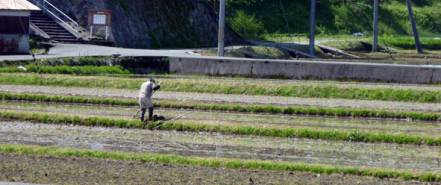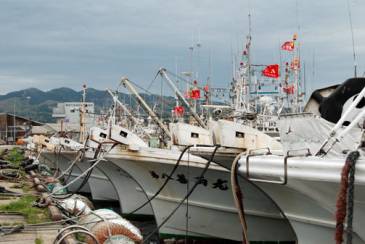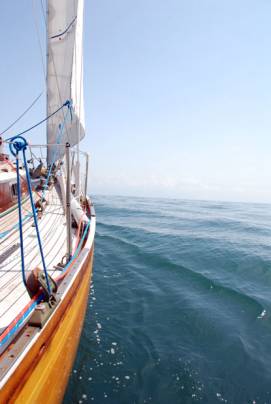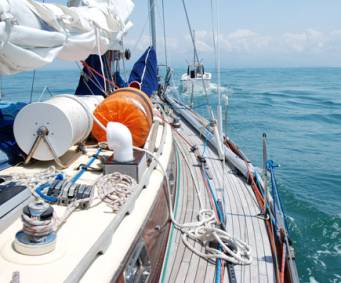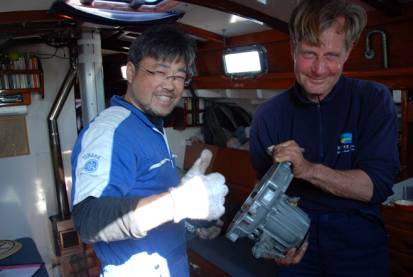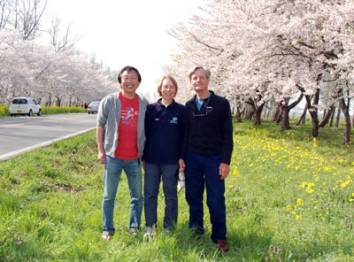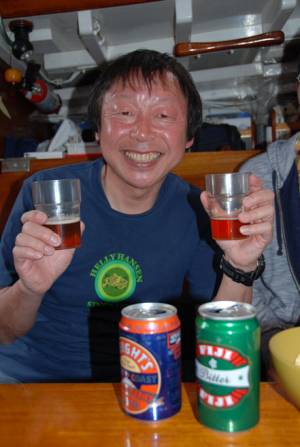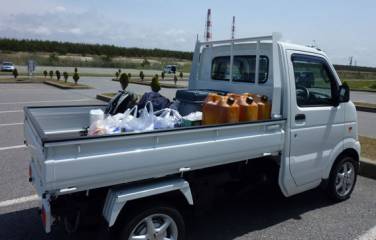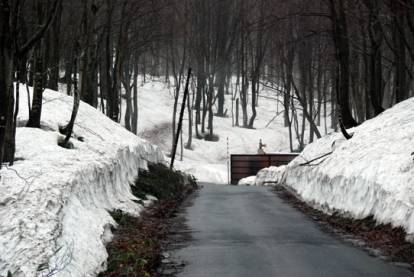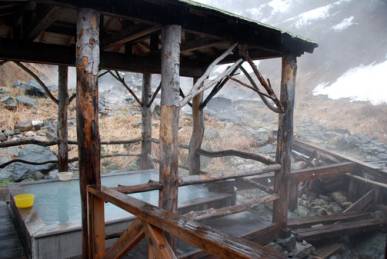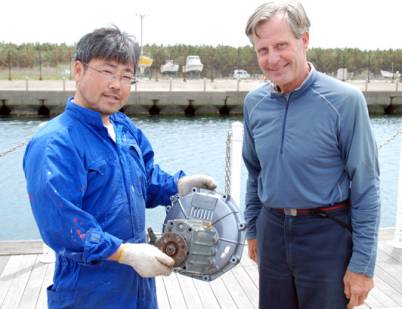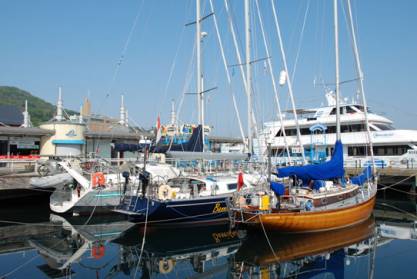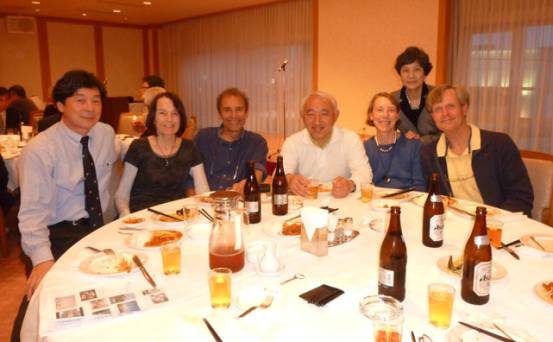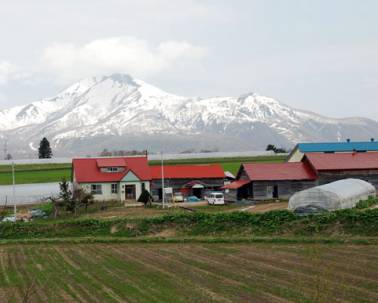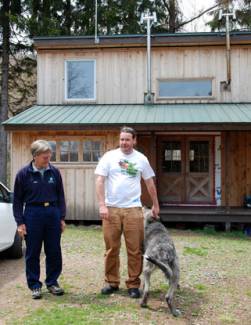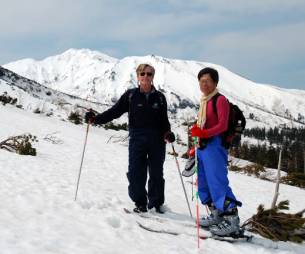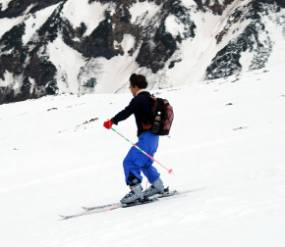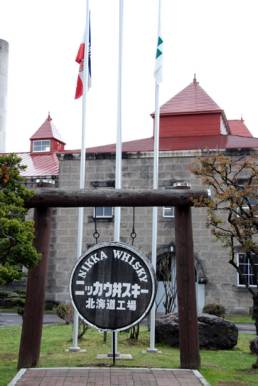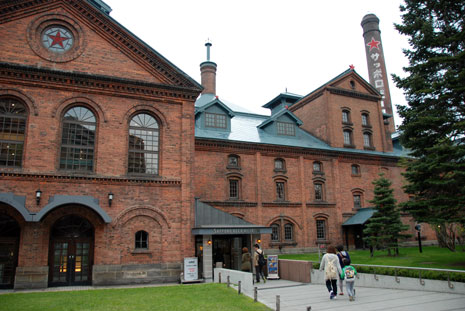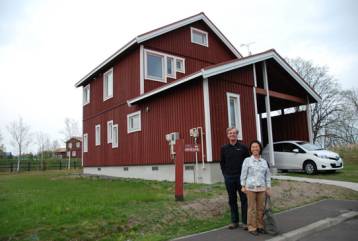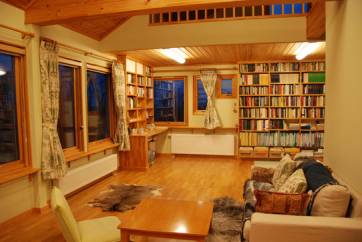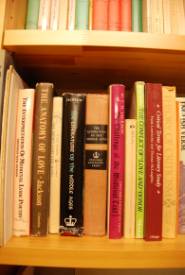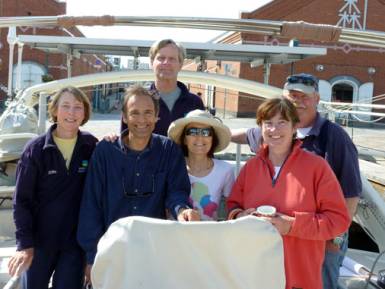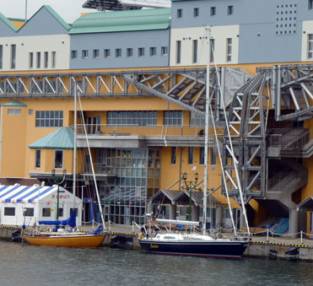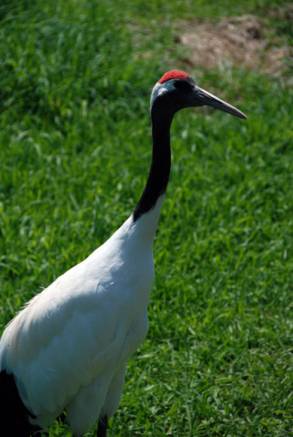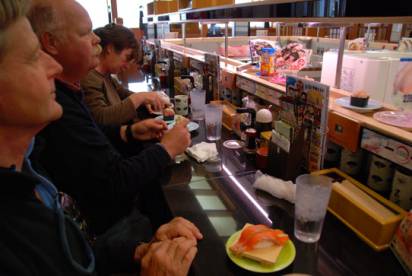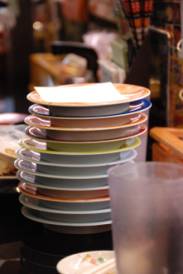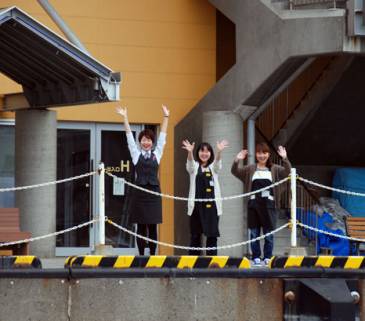Nagasaki to
Kushiro
|
To
set the tone for our passages north in the Sea of Japan up the west coast of
Honshu, we had a good quartering breeze to speed us through the night toward the
west coast of Tsushima, which is actually two islands, separated by a narrow
channel. It was the entrance to this channel for which we were aiming – not
helped by the fog which rose with the dawn. However, the fog cleared as we
made our entrance on the west coast and we wriggled our way past numerous
fish farms to the spot where Kakihara San had said was a sheltered pontoon.
At first it appeared to be a blank wall in the rock and trees until we were
nearly upon it. We circled, reconnoitred, and made our plunge. The tiny
channel was no more than 10 metres wide with rocks to starboard and a
concrete dock to port. The pontoon had a small pool about ‘Sunstone’s’ length
beyond it. Vicky leapt with a bow rope, threw turns around a bollard and we
hand-brake turned into the pool, ending up with our bow pointing back out. A
little warping saw us neatly alongside in the tidiest hurricane hole
imaginable. We happily sat out strong winds for the next few days, biking to
the main town and using the onsen, which overlooked our mooring. It was the
most rural setting in which we had moored so far in Japan and it was a
pleasure. |
|
|
|
|
With
the bikes finally showing their age, Tom had to jury-rig a pedal when the thread
on the crank stripped. The result was very shiny and ensured that peddies
could hear him coming because of its distinctive clanking noise. |
|
However
we knew we must move on and so set off a few days later through the narrow cut
made by the Japanese Navy to move their warships freely. We had a fast
passage in blustery winds back eastwards to the Honshu coast and entered Hagi
the following morning. We found a convenient spot in the main fishing
harbour, once again avoiding the excessively expensive and mostly empty
marina. |
|
|
|
The
town itself was unusual and interesting. Hagi did not suffer bombing and as a
result still has a large area of old samurai residences in the quarter of town
near the now ruined castle. We had a long bike ride up another must-see
volcano and inspected the ceramics for which the town is famous. |
|
|
|
|
|
|
Katsunori
San kindly drove us on a sightseeing tour of Nishoinomia on our first day there,
taking in the remarkable cliffs and rocky west coast of the islands well as
its wild horses which graze where they will. |
|
|
Our
passion for island visits and our good experience with Tsushima dictated our next
stop at Nishinoshima in the Oki Shoto group of islands. Yamada San in
Onomichi had given us the name of a friend who had a hotel there with a dock.
Another overnight trip saw us safely among the islands. After a little
searching we found the somewhat dilapidated pontoon and were waved alongside.
Thus began one of the nicest few days of our cruise. Katsunori San ran the
restaurant associated with the hotel and his fisherman friend Ken San had a
keen interest in boats, as well as many other things. They also called on
Nicola, a transplanted Kiwi with a Japanese partner to help us explore the
island. As so often in Japan one thing and one person leads to another and we
soon seemed to have a network of friends on the island keen to show us
everything. Despite the usual coastline of concrete fishing harbours, much of
the island was undeveloped and pleasantly wooded. We hiked and were driven
over much of the landscape and thoroughly enjoyed ourselves. We are sincerely
grateful to the generosity of our friends on Nishinoshima. |
|
|
|
|
|
We
took a couple of delightful hikes on Nishinoshima. The first began where
local people were cleaning up the rocky beaches and led up a path along the cliffs
and then back down along a winding road festooned with spring flowers. The
second hike to the highest point on the island also led to a wonderful shrine
sunk artly in a cave and buttressed by a huge tree. |
|
|
|
|
|
Ken
San was a fascinating companion. He is a fisherman and mechanic. Though his
English was somewhat uncertain, he has a lively, enquiring mind which ranges
everywhere. We had many interesting conversations with him. With Katsunori
San he had made a beautiful model of his own 60’ squid boat, which was given
pride of place in the restaurant. Though she loves Japan and has a Japanese
partner, Nicola was delighted to spend some time speaking English to adopted
Kiwis and she was a mine of information, both about the island and Japanese
culture generally. |
|
|
|
|
|
|
|
From
Okishoto, another night sail took us to Ine. This is an old and very
interesting fishing village, in that many of the wooden houses are built out over
the water with a kind of garage for the family boat underneath. Many of the
houses are quite old. By chance this was also the venue for another cruiser
gathering. ‘Bannister’ had been moving steadily up the coast making more
stops than ourselves, as had ‘Kauana’, a large French yacht with Remi and
Helene aboard, whom we had met in Hiroshima. We lined up along a quay, almost
certainly more foreign yachts than Ine had ever seen all at once. From Ine we
took a 50 km bike ride the next day south along the coast to Amanohashidate,
a sand spit that is a big tourist stop in Japan. The place was packed with
weekend tourists, as the town is in fact only a short distance by train from
Kyoto and Osaka. By the time we returned both ‘Bannister’ and ‘Kauana’ had left.
They were wise. The following day the wind filled in strongly from the
southwest. Despite the apparently good shelter, the harbour became a mass of
steep waves which threatened to throw ‘Sunstone’ onto the quay. We bailed out
while we still could and before the wind shifted to pin us to the dock.
Initially we thought we might try to anchor locally, but on consideration
decided to head straight for Wajima. |
|
|
|
|
At the left Vicky is adopting the recommended position for viewing the sand spit, which is then supposed to resemble the ‘Floating Bridge of Heaven’. She wasn’t convinced. Spring
was moving on rapidly, despite our progress north. As a result we saw our
first flooded rice paddies while biking back toward Ine. |
|
We
reached Wajima the following morning after a straightforward night at sea –
until the last few miles when we were attacked by 40-50 knot williwaws. Fortunately
it was calmer as we circled the packed fishing harbour several times and
finally decided on our spot, managed just to get Vicky ashore with a line and
then heard a very unhappy grinding sound from the engine. Fortunately we
managed to complete our docking without further use of power. On examination
it was clear that the gearbox was not in a happy state. We had several thoughts
about the possible problem but nothing conclusive. We knew that we were
already into Golden Week, one of the few longer holiday periods in Japan, and
so were likely to have problems getting anything done. ‘Bannister’ pulled in
later in the day. We decided to see if there was any help to be had from the
local Yanmar engineers and if not, then perhaps it would be possible for
‘Bannister’ to tow us clear of the harbour and we would sail to Akita where
we knew we had contacts, both through Kakihara San and through another
Japanese friend, Sakae San, who we had met in Fukuoka. In the event, we
decided on the latter plan, having consulted inconclusively for an hour with
Yanmar engineers, who had no clear idea about the possible problem and in any
case could not order parts for at least a week. We took up Hendrik and
Hanna’s kind offer of a tow out to sea the following morning and ‘geared’
ourselves up to get into race mode for some light air sailing – very, very
light! |
|
|
|
|
Wajima harbour was jam packed with fishing boats, all taking advantage of the Golden Week holiday. Our
sail north to Akita was in the lightest of light airs. |
|
However,
while we were sailing, our now extensive network of Japanese friends was busily
at work. As a result by the time we got to within 8 miles of Akita Marina on
Thursday morning, a motor boat shot along side. The owner gestured to his
phone and called the marina. Half an hour later, Shougo San pulled up with
the marina launch and took us in tow. It turned out that Shougo San was also
a first class marine engineer and a no-nonsense, let’s-get-on-with-it worker.
Though it was a holiday, when asked if he might be able to look at the
gearbox the next day, he said, ‘Ie, ima!’ - ‘No, now!’ Fortunately he also
spoke some English. By shortly after lunch we had the gearbox off the engine
and on the way to Shougo’s workshop. The following morning he reported that
the front casing was cracked and would have to be replaced. Unfortunately the
part would have to come from the manufacturer in Osaka and couldn’t be
delivered before Wednesday of the following week. Nevertheless, by Thursday,
one week on, we had the refurbished gearbox back and refitted. It worked
beautifully. |
|
|
|
|
|
|
|
|
|
In
the meantime we had made friends with Enoki San, through the kind efforts of
Sakae San in Fukuoka. As a result, we had the use of a little yellow plate
pickup and were able not only to do some essential restocking, but also to take
a drive up to the mountains. Unfortunately, to Vicky’s disgust the weather
forecast proved faulty and we had a drizzly day with poor visibility.
However, Enoki San kindly took us to view a spectacular display of cherry
blossoms amidst areas of vivid yellow rape flowers. Despite the enforced
delay we had a delightful time in Akita. |
|
|
|
|
|
Shougo
San was a pleasure to work with. He delighted in doing a job well and
quickly. Despite the language barriers he was quick to understand both potential
problems and their solutions. We have rarely had such a good time working
with a really skilled and intelligent craftsman. |
|
‘Bannister’
had continued on ahead, going straight from Shodoshima to Hakodate on Hokkaido.
They had a boisterous trip and as we set off we had much the same, with
strong SWlies pushing us almost too quickly. The Tsugaru Kaikyo, the strait
between Honshu and Hokkaido, has a very strong east-going current and a
tendency to accelerate winds. It lived up to its reputation and at times we
were doing 9 knots over the ground with only the No 4 and three reefs.
However the wind eased conveniently just before we entered Hakodate in the
watery dawn light and we managed to tie up next to ‘Bannister’ in a nicely
protected notch at the southern end of the harbour. ‘Kauana’ came in a few
days later. |
|
|
|
Once
again we were hosted and helped by another wonderful Japanese contact, Mizuno
San, who speaks excellent English, as does his wife. Through Mizuno San, we
attended a delightful evening with local yacht club members and were
generally helped to enjoy our time in Hakodate. |
|
Only
two days after we arrived, we set off on a five-day road trip around the
southern half of Hokkaido. We saw some beautiful rural countryside and some
spectacular mountain scenery as well as making several new friends, including
Nick and Rika and Ichikawa San. The order of the photos of our trip is more
thematic than chronological! |
|
|
Hokkaido’s
countryside is a mixture of the bucolic and the dramatic. By the purest
chance we met Nick and his Japanese partner, Rika, when they were looking down
on the boats in Hakodate. Nick is a Kiwi who runs a skiing related business
in the mountains of central Hokkaido, but also maintains an interest in
sailing and hopes to go cruising in the long-term. |
|
|
|
Our
other fortunate meeting was with Ichikawa San when we were staying at the
hostel/hotel at Fukiage in Daisetsuzan National Park. He kindly agreed to let
us tagalong with him on one of his usual climbs up the local mountains. He
climbed with special skins on his skis, while we clambered in our boots. From
the top he then darted off down hill. Though he kindly stopped occasionally
to see how we were doing on the way down. It was an exhilarating day out. |
|
|
|
|
|
During
our travels around Hokkaido, Vicky was determined to sample the alcohol of
the locals, first at the Nikka Whisky distillery and then at the Sapporo
brewery. Tom, of course abstained – but only because he was driving. Japanese
drink-drive laws are fierce, allowing 0.0% blood alcohol levels. |
|
|
|
|
Visiting
Sapporo also gave us a chance to catch up again with Setsuko, Tom’s father’s
former student and now retired professor herself. Her Norwegian style house in
the suburbs of Sapporo is both comfortable and suitable for serious scholarly
study. It
was a pleasure not only to see Setsuko again in this relaxed atmosphere but
also to see Tom’s Dad’s books given pride of place on her shelves. |
|
|
Our stay in Hakodate was a pleasure, but we had
come the decision that it would be best for us to make it our last port in
Japan. We stocked up, filled with water and diesel and were all set to go –
when typhoon Songda appeared on the horizon. As with most typhoons, it’s
track was not at all certain and for a time it appeared that it would move
straight over the top of our own track within a few days of our departure. We
postponed initially and then decided to cut our losses somewhat by returning
to plan B and head north and east to Kushiro, on Hokkaido, to await
developments. That is where we are now, once again with ‘Bannister’. Once
again we are ready to leave and this time we hope to do so, on 1 June 2011. |
|
|
|
|
|
|
|
|
During
our brief stay in Kushiro we made a quick trip out into the countryside to
see the areas famous cranes and also to have a lunch, a typically Japanese
invention, the conveyor belt sushi restaurant, where the menu dishes go by on
conveyor and you pluck them off according to your liking. The bill is then
reckoned by the number and colour of the plates which you stack up as a
result. |
|
|
|
|
We had a fascinating and delightful time in Japan. The Japanese people we met could not have been more helpful and hospitable. Though there were times when the social and linguistic demands were exhausting, the rewards were great and we will remember our time in Japan with great pleasure. Typically,
the young women working at the small tourist information desk at the mall
next to our Kushiro mooring, turned out to wave us farewell as we motored out
of the foggy harbour. |
Next |




















